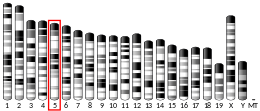CNO (gene)
Protein cappuccino homolog is a protein that in humans is encoded by the CNO gene.[5][6][7]
| BLOC1S4 | |||||||||||||||||||||||||
|---|---|---|---|---|---|---|---|---|---|---|---|---|---|---|---|---|---|---|---|---|---|---|---|---|---|
| Identifiers | |||||||||||||||||||||||||
| Aliases | BLOC1S4, BCAS4L, BLOS4, CNO, biogenesis of lysosomal organelles complex 1 subunit 4 | ||||||||||||||||||||||||
| External IDs | OMIM: 605695 MGI: 1929230 HomoloGene: 10155 GeneCards: BLOC1S4 | ||||||||||||||||||||||||
| |||||||||||||||||||||||||
| |||||||||||||||||||||||||
| |||||||||||||||||||||||||
| Orthologs | |||||||||||||||||||||||||
| Species | Human | Mouse | |||||||||||||||||||||||
| Entrez | |||||||||||||||||||||||||
| Ensembl | |||||||||||||||||||||||||
| UniProt | |||||||||||||||||||||||||
| RefSeq (mRNA) | |||||||||||||||||||||||||
| RefSeq (protein) | |||||||||||||||||||||||||
| Location (UCSC) | Chr 4: 6.72 – 6.72 Mb | Chr 5: 36.75 – 36.75 Mb | |||||||||||||||||||||||
| PubMed search | [3] | [4] | |||||||||||||||||||||||
| Wikidata | |||||||||||||||||||||||||
| |||||||||||||||||||||||||
This intronless gene encodes a protein that may play a role in organelle biogenesis associated with melanosomes, platelet dense granules, and lysosomes. A similar protein in mouse is a component of a protein complex termed biogenesis of lysosome-related organelles complex 1 (BLOC-1), and is a model for Hermansky–Pudlak syndrome. The encoded protein may play a role in intracellular vesicular trafficking.[7]
Interactions
CNO (gene) has been shown to interact with BLOC1S2[8] and PLDN.[8]
gollark: Why do you need much else?
gollark: Are you sure it couldn't just be* send money → share address* share address holds money until it's a multiple of (number of shares)* distribute money → share addresses
gollark: Well, at least it's not PHP.
gollark: What language were you using?
gollark: How do you enforce money actually going to the company or whatever address (I assume you have those)?
References
- GRCh38: Ensembl release 89: ENSG00000186222 - Ensembl, May 2017
- GRCm38: Ensembl release 89: ENSMUSG00000060708 - Ensembl, May 2017
- "Human PubMed Reference:". National Center for Biotechnology Information, U.S. National Library of Medicine.
- "Mouse PubMed Reference:". National Center for Biotechnology Information, U.S. National Library of Medicine.
- Ciciotte SL, Gwynn B, Moriyama K, Huizing M, Gahl WA, Bonifacino JS, Peters LL (May 2003). "Cappuccino, a mouse model of Hermansky-Pudlak syndrome, encodes a novel protein that is part of the pallidin-muted complex (BLOC-1)". Blood. 101 (11): 4402–7. doi:10.1182/blood-2003-01-0020. PMID 12576321.
- Gwynn B, Ciciotte SL, Hunter SJ, Washburn LL, Smith RS, Andersen SG, Swank RT, Dell'Angelica EC, Bonifacino JS, Eicher EM, Peters LL (Dec 2000). "Defects in the cappuccino (cno) gene on mouse chromosome 5 and human 4p cause Hermansky-Pudlak syndrome by an AP-3-independent mechanism". Blood. 96 (13): 4227–35. PMID 11110696.
- "Entrez Gene: CNO cappuccino homolog (mouse)".
- Starcevic, Marta; Dell'Angelica Esteban C (Jul 2004). "Identification of snapin and three novel proteins (BLOS1, BLOS2, and BLOS3/reduced pigmentation) as subunits of biogenesis of lysosome-related organelles complex-1 (BLOC-1)". J. Biol. Chem. 279 (27): 28393–401. doi:10.1074/jbc.M402513200. ISSN 0021-9258. PMID 15102850.
External links
- Human BLOC1S4 genome location and BLOC1S4 gene details page in the UCSC Genome Browser.
Further reading
- Gerhard DS, Wagner L, Feingold EA, et al. (2004). "The status, quality, and expansion of the NIH full-length cDNA project: the Mammalian Gene Collection (MGC)". Genome Res. 14 (10B): 2121–7. doi:10.1101/gr.2596504. PMC 528928. PMID 15489334.
- Starcevic M, Dell'Angelica EC (2004). "Identification of snapin and three novel proteins (BLOS1, BLOS2, and BLOS3/reduced pigmentation) as subunits of biogenesis of lysosome-related organelles complex-1 (BLOC-1)". J. Biol. Chem. 279 (27): 28393–401. doi:10.1074/jbc.M402513200. PMID 15102850.
- Ota T, Suzuki Y, Nishikawa T, et al. (2004). "Complete sequencing and characterization of 21,243 full-length human cDNAs". Nat. Genet. 36 (1): 40–5. doi:10.1038/ng1285. PMID 14702039.
- Li W, Zhang Q, Oiso N, et al. (2003). "Hermansky-Pudlak syndrome type 7 (HPS-7) results from mutant dysbindin, a member of the biogenesis of lysosome-related organelles complex 1 (BLOC-1)". Nat. Genet. 35 (1): 84–9. doi:10.1038/ng1229. PMC 2860733. PMID 12923531.
- Strausberg RL, Feingold EA, Grouse LH, et al. (2003). "Generation and initial analysis of more than 15,000 full-length human and mouse cDNA sequences". Proc. Natl. Acad. Sci. U.S.A. 99 (26): 16899–903. Bibcode:2002PNAS...9916899M. doi:10.1073/pnas.242603899. PMC 139241. PMID 12477932.
- Moriyama K, Bonifacino JS (2003). "Pallidin is a component of a multi-protein complex involved in the biogenesis of lysosome-related organelles". Traffic. 3 (9): 666–77. doi:10.1034/j.1600-0854.2002.30908.x. PMID 12191018.
This article is issued from Wikipedia. The text is licensed under Creative Commons - Attribution - Sharealike. Additional terms may apply for the media files.



